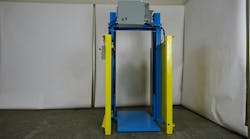Hoist Ring Thinks Independently
RUD presents a hoist ring with an innovative spring mechanism for more safety. The mechanics of the RUD ACP-TURNADO ensure that the anchor point always immediately turns in the load direction when raising the load. This constructively prevents a dangerous stop of the bracket and the associated high shearing forces. This also rules out the feared dropping of the load as a result of the sudden turning of the bracket. In addition, through its optimized design and its special screw technology, the anchor point facilitates higher working load limits of up to 30%. An RFID transponder is installed as standard to simplify the inspection of operating equipment.
Above all, the ACP-TURNADO removes the two known weaknesses of normal central anchor points. If its bracket remains in the "Worst-Case-Position" during lifting, large shear forces and bending moments affect it. This can result in damage or even breakage. If the bracket then suddenly turns out of this position, the load mostly drops suddenly. Damage to the load, anchoring and even to crane components are often the result.
Thanks to the specific design, it is impossible for the bracket to stop. The heart of these mechanics is a spring, which prevents a fatal 90-deg. position of the bracket and during lifting moves it without fail in the direction of the optimal force transfer. As this "Worst-Case-Position" is therefore avoided, a sudden dropping of the load is no longer possible.
In addition: The designs of other central anchor points favor so-called kinks of the hook in the bracket and thus make it more difficult to achieve a secure sit and an optimal force transfer. Thanks to the round bracket design of the RUD ACP-TURNADO, a reliable sit of the hook is guaranteed. Component damage is also prevented by this.
As the screw at the critical transfer from the anchor point to the load is exposed to extreme loads, the developers from RUD have also optimized this considerably.
Firstly, the so-called RUD ICE-BOLT screw comprises a RUD steel specially developed for this use, which combines maximum strength with very high toughness. As a result, it withstands the particularly high statically and dynamically bending loads. Additionally, the anchor point is reinforced at the locations most exposed to loads and is optimized both in terms of the height and the shape.
Apart from safety-relevant aspects, the RUD ACP-TURNADO also offers benefits when handling. As a result of the abrasion lenses at the critical points of the load transfer, it is easy to determine whether the anchor point has already reached discard criteria. Furthermore, the combi-head screw is undetachable but changeable: a useful product feature for everyday use because it makes handling noticeably easier.
The TURNADO is currently available with screw diameters M12/½, M16/5/8, M20/¾, M24/1, and M30/1 ¼ in.
As extensive testing of lifting tackle and legally secure documentation are required in an increasing number of countries, RUD installs RFID transponders as standard – also in the TURNADO.
This allows the anchor point to be identified clearly by a factory-set ID number and to transfer this by laptop or mobile device to corresponding software tools. This process reduces inspection costs and times and also leads to considerably more process reliability because faults can be avoided. Users of lifting tackle can manage test data and documents either in their own databases or they can use the cloud-based resource management tool Aye-D.Net. This is available from the RUD Partner Syfit.





